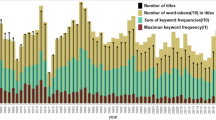Abstract
This paper is devoted to the analysis of career paths and employability. The state-of-the-art on this topic is rather poor in methodologies. Some authors propose distances well adapted to the data, but are limiting their analysis to hierarchical clustering. Other authors apply sophisticated methods, but only after paying the price of transforming the categorical data into continuous, via a factorial analysis. The latter approach has an important drawback since it makes a linear assumption on the data. We propose a new methodology, inspired from biology and adapted to career paths, combining optimal matching and self-organizing maps. A complete study on real-life data will illustrate our proposal.
Preview
Unable to display preview. Download preview PDF.
Similar content being viewed by others
References
Abbott, A., Forrest, J.: Optimal matching methods for historical sequences. Journal of Interdisciplinary History 16, 471–494 (1986)
Abbott, A., Hrycak, A.: Measuring resemblance in sequence data: An optimal matching analaysis of musicians carrers. American Journal of Sociolgy 96(1), 144–185 (1990)
Abbott, A., Tsay, A.: Sequence analysis and optimal matching methods in sociology. Review and prospect. Sociological Methods and Research 29(1), 333 (2000)
Brzinsky-Fay, C.: Lost in Transition? Labour Market Entry Sequences of School Leavers in Europe. European Sociological Review 23(4), 409–422 (2007)
Conan-Guez, B., Rossi, F., El Golli, A.: Fast algorithm and implementation of dissimilarity Self-Organizing Maps. Neural Networks 19(6-7), 855–863 (2006)
Gabadinho, A., Ritschard, G., Studer, M., Müller, N.S.: Mining Sequence Data in R with TraMineR: a user’s guide (2008), http://mephisto.unige.ch/traminer
Gauthier, J.A., Widmer, E.D., Bucher, P., Notredame, C.: How much does it cost? Optimization of costs in sequence analysis in social science data. Sociological Methods and Research (in press) (2008)
Giret, J.F., Rousset, P.: Classifying qualitative time series with SOM: the typology of career paths in France. In: Computational and ambient intelligence, IWANN 2007 Proceedings, pp. 757–764. Springer, Berlin (2007)
Grelet, Y., Fenelon, J.-P., Houzel, Y.: The sequence of steps in the analysis of youth trajectories. European Journal of Economic and Social Systems 14(1) (2000)
Kohonen, T., Somervuo, P.: Self-organizing maps for symbol strings. Neurocomputing 21, 19–30 (1998)
Kohonen, T.: Self Organizing Maps. Springer, Berlin (1995)
Müller, N.S., Ritschard, G., Studer, M., Gabadinho, A.: Extracting knowledge from life courses: Clustering and visualization. In: Song, I.-Y., Eder, J., Nguyen, T.M. (eds.) DaWaK 2008. LNCS, vol. 5182, pp. 176–185. Springer, Heidelberg (2008)
Needleman, S., Wunsch, C.: A general method applicable to the search for similarities in the amino acid sequence of two proteins. Journal of Molecular Biology 48(3), 443–453 (1970)
Wu, L.: Some comments on Sequence analysis and optimal matching methods in sociology, review and prospect. Sociological methods and research 29(1), 41–64 (2000)
Author information
Authors and Affiliations
Editor information
Editors and Affiliations
Rights and permissions
Copyright information
© 2009 Springer-Verlag Berlin Heidelberg
About this paper
Cite this paper
Massoni, S., Olteanu, M., Rousset, P. (2009). Career-Path Analysis Using Optimal Matching and Self-Organizing Maps. In: Príncipe, J.C., Miikkulainen, R. (eds) Advances in Self-Organizing Maps. WSOM 2009. Lecture Notes in Computer Science, vol 5629. Springer, Berlin, Heidelberg. https://doi.org/10.1007/978-3-642-02397-2_18
Download citation
DOI: https://doi.org/10.1007/978-3-642-02397-2_18
Publisher Name: Springer, Berlin, Heidelberg
Print ISBN: 978-3-642-02396-5
Online ISBN: 978-3-642-02397-2
eBook Packages: Computer ScienceComputer Science (R0)




